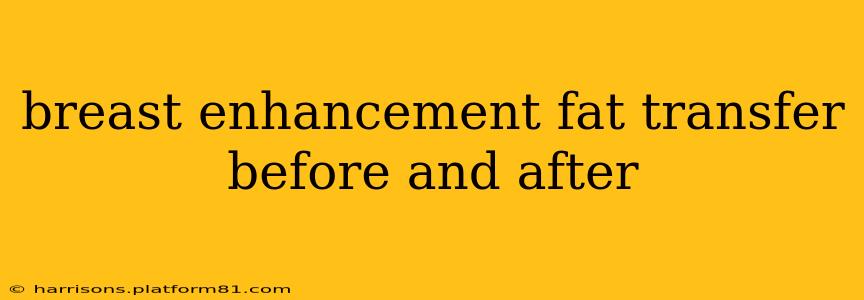Breast augmentation is a popular procedure, and fat transfer, also known as autologous fat grafting, is a fantastic alternative to breast implants. This technique uses your own body fat to enhance your breasts, offering a natural and often less invasive approach. This comprehensive guide explores breast enhancement fat transfer, covering before-and-after results, the procedure itself, recovery, and potential risks.
What is Breast Enhancement Fat Transfer?
Breast enhancement fat transfer involves harvesting fat from one area of your body (often the abdomen, thighs, or hips) and carefully purifying it before injecting it into your breasts to increase their size and improve their shape. This minimally invasive procedure uses your own tissue, minimizing the risk of rejection and providing a more natural-looking outcome compared to breast implants.
Before & After Photos: Real Results
While individual results vary based on factors like starting breast size, the amount of fat transferred, and your body's healing process, numerous before-and-after photos online demonstrate the impressive results achievable with fat grafting. These images showcase increased breast volume, improved breast shape, and a more natural aesthetic. However, remember that these are just examples, and your results may differ. It's crucial to consult a qualified plastic surgeon to discuss realistic expectations based on your individual anatomy.
How is the Procedure Performed?
The procedure typically involves three main steps:
- Liposuction: Fat is extracted from a donor site using liposuction. This involves small incisions and a cannula to gently suction out fat cells.
- Processing: The extracted fat is then processed to remove excess fluid and impurities, resulting in a purified fat graft ready for injection.
- Injection: The purified fat is carefully injected into the breasts using small cannulas, strategically placed to achieve the desired shape and volume.
The entire procedure may take several hours, depending on the amount of fat transferred and the complexity of the case.
What Happens After the Procedure?
Post-operative care is crucial for optimal results. Expect some discomfort, swelling, and bruising in both the donor and recipient sites. Your surgeon will provide specific post-operative instructions, which may include:
- Compression garments: Wearing compression garments helps minimize swelling and support the breasts.
- Medications: Pain relievers and antibiotics may be prescribed to manage pain and prevent infection.
- Follow-up appointments: Regular follow-up appointments allow your surgeon to monitor healing and assess the results.
How Long is the Recovery Time?
Recovery time varies from patient to patient, but you can generally expect to resume light activities within a few days. More strenuous activities should be avoided for several weeks. The swelling and bruising gradually subside over several weeks or months.
Does Fat Transfer Breast Augmentation Work for Everyone?
While breast augmentation with fat transfer is a valuable option for many, it’s not suitable for everyone. Factors that may influence suitability include:
- Amount of body fat: You need sufficient body fat to harvest for grafting.
- Desired volume increase: Significant breast augmentation may require multiple procedures.
- Skin elasticity: Good skin elasticity is important for achieving optimal results and avoiding sagging.
- Overall health: Certain medical conditions may preclude the procedure.
Is Fat Transfer Permanent?
Unfortunately, fat transfer isn't entirely permanent. A certain percentage of the transferred fat is typically reabsorbed by the body in the weeks and months following the procedure. The amount of fat that survives depends on various factors, including the patient's body and the surgeon's technique. Multiple sessions might be needed to achieve the desired final result.
What are the Potential Risks and Complications?
As with any surgical procedure, fat transfer breast augmentation carries potential risks and complications, including:
- Infection: Although rare, infection can occur at either the donor or recipient site.
- Swelling and bruising: These are common and generally subside over time.
- Fluid collection (seroma): This can be drained with a needle.
- Fat necrosis (fat cell death): This can result in lumps or irregularities.
- Asymmetry: Achieving perfect symmetry can be challenging.
- Unsatisfactory results: Sometimes, the augmentation doesn’t meet the patient’s expectations.
It’s essential to discuss these risks with your surgeon during your consultation.
What is the Cost of Breast Enhancement Fat Transfer?
The cost varies based on several factors, including the surgeon's fees, anesthesia costs, facility fees, and the complexity of the procedure. It's advisable to consult with several plastic surgeons to get a clearer picture of the costs involved.
Finding a Qualified Surgeon
Choosing a qualified and experienced plastic surgeon is crucial for a successful outcome. Look for board-certified plastic surgeons with extensive experience in fat transfer breast augmentation. Review their before-and-after photos, read patient testimonials, and schedule consultations to discuss your goals and expectations.
This comprehensive guide provides a wealth of information on breast enhancement fat transfer. Remember that this information should not be considered medical advice. Always consult a qualified plastic surgeon for personalized guidance and to determine if fat transfer is the right choice for you.
